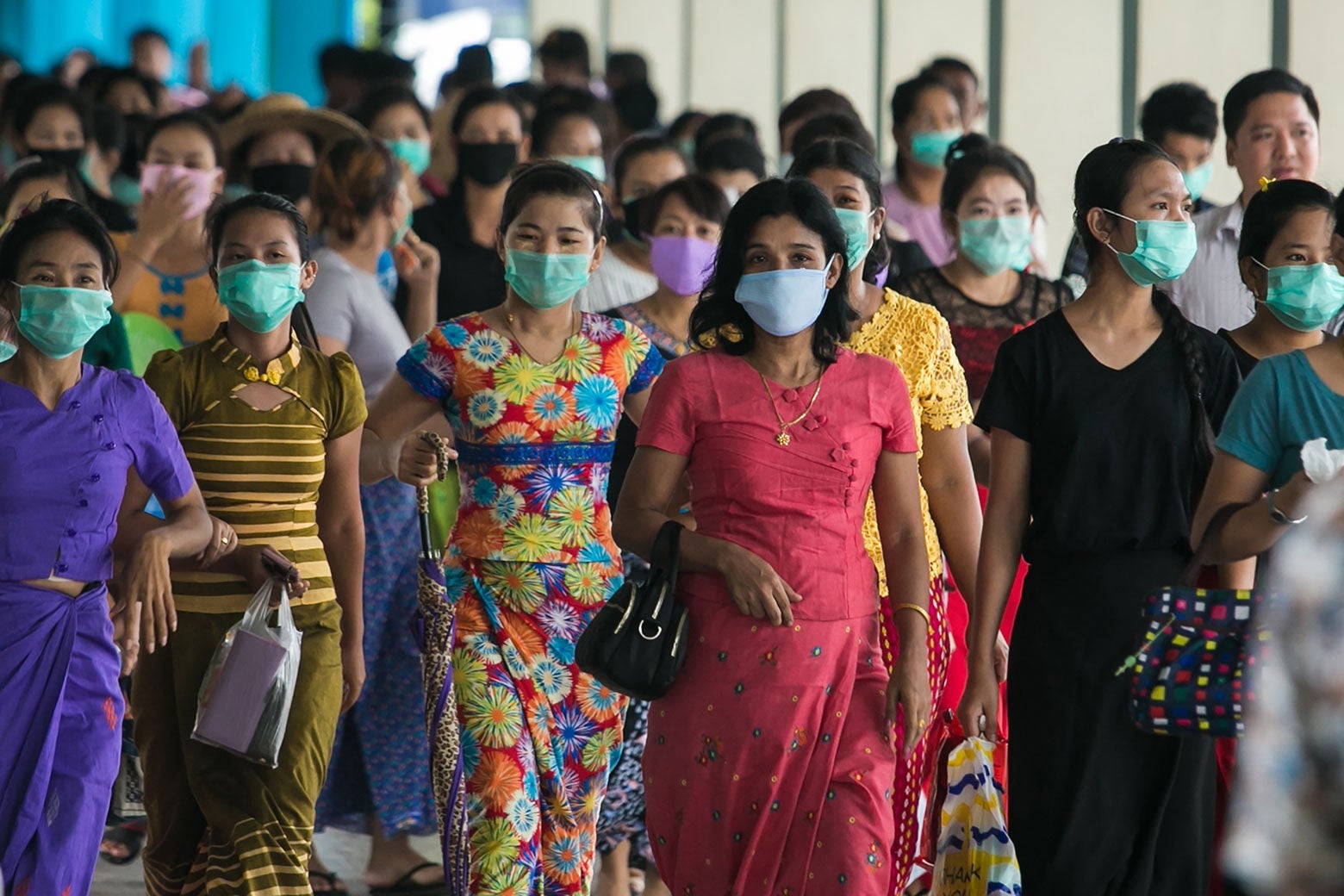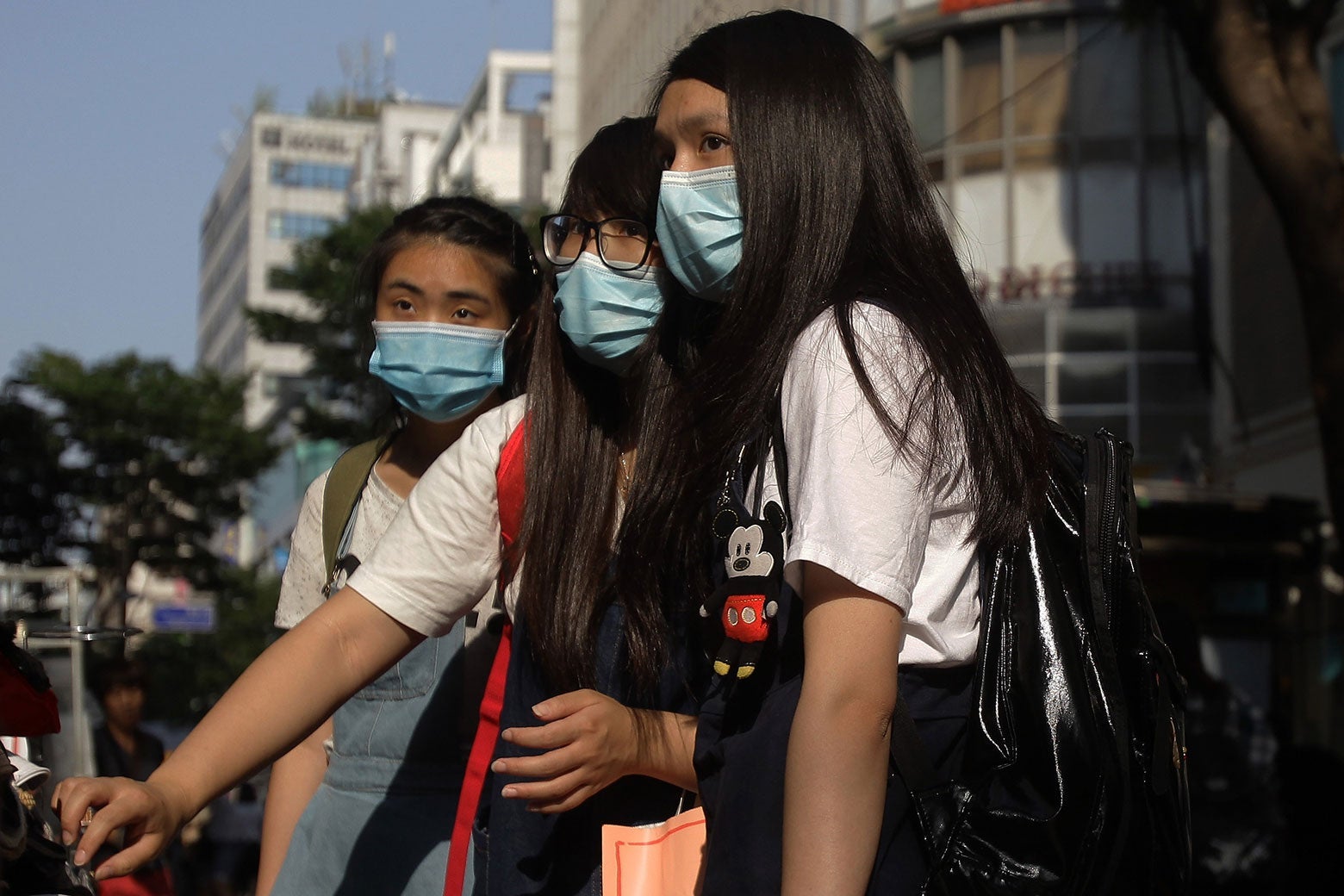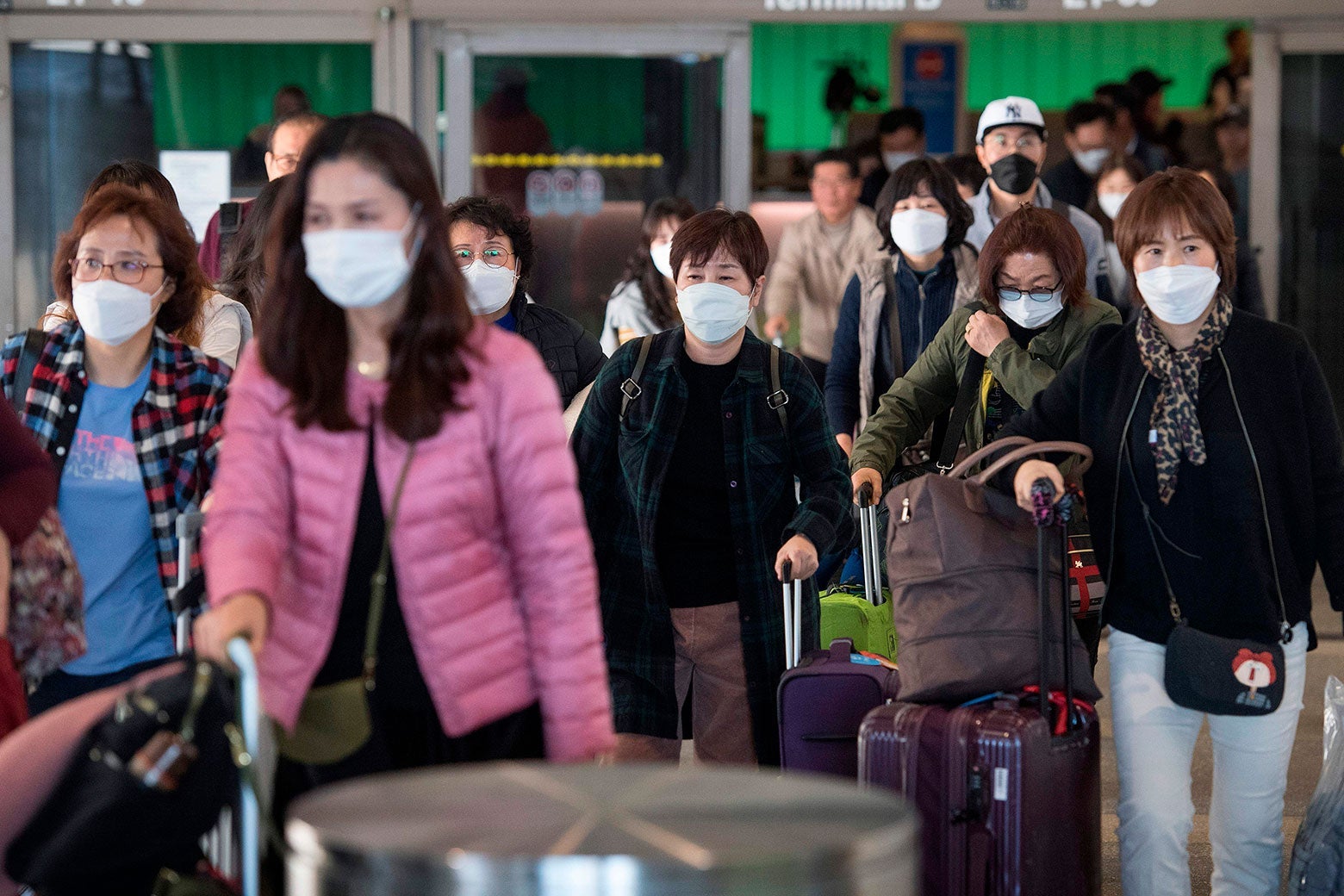On Wednesday, China confirmed that almost 6,000 people have been infected with the new coronavirus scientists are calling 2019-nCoV. The progress of 2019-nCoV, as witnessed via media, feels both scary and familiar. As the 21st century moves forward, and we lose all sense of time and space, one pandemic panic seems to merge into another. (As a reminder, a pandemic is when a new disease strain spreads beyond a local epidemic into a large regional or worldwide event.) Here’s a brief timeline of the emerging infectious diseases that have made headlines this century—with updates on what we’ve learned since they were the focus of global concern.
2002–03: SARS: severe acute respiratory syndrome, a serious pneumonia caused by a coronavirus called SARS-CoV
What happened: The first casualty of SARS died in Guangdong, China, in November 2002. No drugs were effective against this sickness, which presented as serious pneumonia, and health care workers were especially hard-hit. The World Health Organization believes 8,098 people were eventually infected in 29 countries; the death toll ended up being about 774, with the death rate at about 9 percent to 12 percent of those who were diagnosed.
International cooperation helped send the disease into hiding. After researchers published the genetic code of the virus on the internet, epidemiologists determined that isolation, quarantine, and contact tracing would slow the spread of the disease—and, because the nature of the virus that causes SARS meant that victims were most contagious late in its course, when they tended to be hospitalized, these old-school public health measures worked.
A smaller outbreak in 2004 in China seems to have its origins in people who were working with the virus in a medical lab. The WHO declared SARS contained in 2005.
How we responded: SARS set the stage for the 21st-century debate over whether the answer to global pandemic should be the defensive sealing of borders or improvements in international coordination that facilitate better tracking and control of a disease’s spread.
In some places, SARS triggered xenophobia and Sinophobia. In North America, newspapers like the New York Post ran China-blaming cartoons. The fact that China’s government initially suppressed information about the virus added to the climate of blame. In an editorial that ran in March 2003, the Wall Street Journal called for the rest of the world to “suspend all travel links with China until it has implemented a transparent public health campaign”—a way for the rest of the world to force China to “act responsibly.” In Canada, where 43 people died, Asian Canadians reported racist comments and loss of business due to SARS panic.
What we’ve learned since then: In 2006, scientists published research arguing that civet cats they had examined carried a virus with the same genetic profile as the one found in human victims. (Civet cats were sold for meat in the area where SARS emerged.) Researchers confirmed in 2017 that a colony of horseshoe bats in Yunnan province may have been the originators of the virus, with civet cats merely acting as the intermediary between bats and humans. Experts hailed the discovery with hopes that a vaccine might emerge—as yet, it has not.
SARS also lives on in labs—including in the Institut Pasteur, in Paris, which famously lost track of more than 2,000 vials containing the virus in 2014.
2003–07: H5N1, or “bird flu”
What happened: This flu strain, first isolated in Guangdong Province, China, in 1996, was confirmed present in a human patient in 1997 in Hong Kong. Starting in late 2003, Korea, China, Thailand, and Vietnam reported a stream of new H5N1 cases in animals—including, most dramatically, in zoo tigers that had been fed on infected chickens—and, then, fatalities among humans.
Migratory birds brought H5N1 across borders, and birds both domesticated and wild could carry it. This flu could pass from person to person, but did so less frequently than some other strains; mortality rates, on the other hand, were high with 6 out of every 10 people known to have been infected dying from H5N1—a total of about 300 global deaths.
But soon, reported infections slowed to a trickle, and the last confirmed human infection was detected in February 2017.
How we responded: With terror. Time’s Feb. 9, 2004, issue featured an egg with a beak breaking through it, and a coverline asking: “Is Asia hatching the next human pandemic?” This cover must have sold well, because the magazine’s Oct. 17, 2005, edition featured a humble white chicken topped by a yellow headline: “DEATH THREAT.” The bird flu also fascinated journalists and science writers. Geographer and journalist Mike Davis published a book in 2005 that warned of a total apocalypse: The Monster at Our Door.
What we learned: This outbreak impressed upon us the importance of the anti-viral oseltamivir (Tamiflu), which had been successfully used to treat patients with H5N1. Several governments began stockpiles. On Nov. 1, 2005, George W. Bush asked Congress to fund America’s stash of Tamiflu and Relenza with a budget of $1 billion. The pandemic also prompted additions to research budgets for flu-related projects.
In a 2019 piece about the legacy of H5N1, Stat’s Helen Branswell wrote that the reasons for the dissipation of this strain aren’t completely understood. H5N1 may have simply mutated into other “bird flu” viruses that are highly pathogenic to both wild and domestic avian populations, but less dangerous to humans—for now. In 2015, the American poultry industry suffered through an outbreak of H5N8 and H5N2 in large chicken flocks in the Midwest; this outbreak, which the USDA linked to migration routes, did not cross over to humans. As recently as November 2019, crows that died en masse in India tested positive for H5N1.
2009: “Swine flu,” caused by the H1N1 virus

What happened: Within one week in mid-April 2009, a 10-year-old boy and a 9-year-old girl in Southern California, both of whom came down sick with the flu, tested positive for a new strain—H1N1. On April 24 of that year, the WHO announced that in March and April, Mexico had reported about 900 cases suspected to have been caused by the same strain, with 60 suspected deaths. The WHO officially declared a pandemic on June 11. By June of that summer, all 50 American states had reported cases, and more than 30 summer camps reported outbreaks. The flu receded as the summer wore on, then had a second wave in the fall of that year.
Finally, in August 2010, the WHO declared the end of the pandemic. Eventually, researchers estimated that at least 300,000 people died (though estimates are necessarily fudgy). Unlike with a more typical seasonal flu, elderly people were less likely to fall sick, because of immunity that derived from a flu strain that circulated in the middle of the 20th century.
How we responded: For this outbreak, we were primed to panic, maybe because of the precedent of SARS and bird flu. Egypt ordered 300,000 pigs killed. At the height of the outbreak, in the summer of 2009, the emergency room at St. Luke’s, in New York City, saw double the usual number of patients—most of them didn’t have the flu but were just scared they had it. Colleges canceled summer programs in Mexico; scammers sold shampoos and hand sprays supposed to protect against “swine flu”; members of Congress pressed the administration to seal the border with Mexico, against the CDC’s advice. The American government went all-in on vaccination and stockpiled anti-virals, despite growing skepticism among scientists about the effectiveness of those measures.
What we learned: “This pandemic has turned out to be much more fortunate than what we feared a little over a year ago,” Margaret Chan of the WHO said in a statement on Aug. 10, 2010. “We have been aided by pure good luck. The virus did not mutate during the pandemic to a more lethal form,” widespread resistance to oseltamivir did not develop, and the vaccine worked well.
The relative mildness of swine flu, after so much buildup, triggered some suspicion. European countries, especially, felt deflated, having spent money on vaccine stockpiles. In June 2010, a joint investigation by the British Medical Journal and the Bureau of Investigative Journalism concluded that the WHO had taken advice from scientists in the course of its pandemic planning who were also being paid by pharmaceutical companies that produced vaccines and anti-virals. Responding to this investigation, the WHO convened an external Review Committee, whose proceedings were to be made open to the public.
The committee recommended that in future, the WHO should increase transparency around its decision-making process, but found that there wasn’t any improper influence exercised in this instance. But, for those media consumers who heard about the accusation but not the exoneration, this affair certainly can’t have boosted their trust in international public health authorities.
2011: Contagion
What happened: Steven Soderbergh spun the previous decade’s pandemic fears into a dark drama with a star-studded ensemble cast, featuring Gwyneth Paltrow as a businesswoman who brings a deadly virus home from a trip to Hong Kong, and Kate Winslet as a scientist who races to figure out what happened.
How we responded: Clearly, Paltrow’s grim hospital-bed scenes struck a nerve. The film grossed more than $136 million worldwide.
What we learned: Although the movie was sophisticated in its representation of epidemiology, and featured a biting portrait of a fraudulent “wellness” guru (Jude Law) making bank off fake cures, we seem to have learned little about consuming pandemic-related information critically, since people are currently circulating misinformation about the latest coronavirus.
2012–present: MERS: Middle East respiratory syndrome, caused by a coronavirus called Middle East Respiratory Syndrome Coronavirus, or MERS-CoV

What happened: MERS-CoV was first identified in a patient in Saudi Arabia in 2012. As with SARS, the disease looks like severe pneumonia; with MERS, patients also have gastrointestinal symptoms, and sometimes experience kidney failure. Since 2012, 27 countries have reported cases, with 2,494 people confirmed infected and 858 dead, mostly in Saudi Arabia. All cases of MERS, the CDC stipulates, have been linked back to people who live in or have traveled to the Arabian Peninsula.
The WHO reports that about 35 percent of MERS-infected people have died, with health care workers at highest risk—though, since MERS can also result in such mild symptoms that a person may have it without knowing it, that death rate is almost certainly inflated.
In 2017, the WHO put SARS-CoV and MERS-CoV on its Priority Pathogen list, hoping to spur further research into coronaviruses.
How we responded: The WHO called an outbreak at a hospital in Seoul, South Korea, in 2015—a patient who had recently returned from the Middle East with what turned out to be MERS was left in an emergency room and a hallway for three days—a “wake-up call” for hospitals trying to manage emerging infectious diseases. As the outbreak in Seoul was at its height in the spring of 2015, the government quarantined almost 17,000 people, and foreign tourists shunned the city. That outbreak in Korea eventually killed 36.
What we learned: Dromedaries, researchers believe, play a major role in the spread of MERS-CoV and have likely transmitted the infection to humans. Scientists have tested other animals—goats, cows, sheep, pigs, birds—for MERS-CoV and haven’t found it. Although we don’t know the whole story, MERS-CoV seems to have first originated in bats, with camels serving as intermediaries between bats and humans, much as civets did in the case of SARS. MERS-CoV can be transmitted not only by the eating of camel meat, or the drinking of camel milk without proper pasteurization, but also by simple proximity between camels and humans.
2013–16: Ebola
What happened: Over the course of 2½ years, this outbreak of the Ebola virus caused 28,600 recognized cases and 11,325 deaths, mostly in Guinea, Sierra Leone, and Liberia. For the first time, the outbreak spread from small towns to urban centers, and public health officials feared a more widespread epidemic.
How we responded: Compared to the strange new flus and coronaviruses of the previous 10 years, Ebola, which had been on American radars since the mid-1990s thanks to Dustin Hoffman and Richard Preston, seemed almost familiar. And very few Americans were ever infected by, or killed by, this outbreak. But that didn’t stop Americans from ranking Ebola the third-most-urgent health problem in the country in November 2014, according to one poll.
Donald Trump, as always, proved helpful in soothing the public, tweeting: “Ebola is much easier to transmit than the CDC and government officials are admitting. Spreading all over Africa—and fast.”
What we learned: In 2014, a wildlife epidemiologist working with a team investigating the origins of the outbreak theorized that the first victim, a 2-year-old boy named Emile who lived in Meliandou, Guinea, may have gotten the disease after playing in a hollow tree where bats also roosted. The discovery underlined the fact that consumption of bush meat—often used by racists as a reason to blame Africans for their own suffering—isn’t the only way outbreaks begin.
The high mortality of health care workers, and the strain on the health care system in affected countries particularly, alarmed public health officials. Modeling effects of the outbreak on mortality from other endemic diseases, public health researchers estimated in a 2016 paper that this Ebola outbreak might result in a significant exacerbation of mortality rates from tuberculosis, HIV/AIDS, and malaria.
In August 2018, the Ministry of Health of the Democratic Republic of Congo notified the world of a new outbreak of Ebola. This new outbreak, unconnected to the one that ended in 2016, was to go on to become the second-worst epidemic of Ebola on record.
2015–16: Zika, transmitted by ZIKV (the Zika virus)
What happened: ZIKV, a virus spread by Aedes aegypti mosquitoes, was first discovered in 1947, but commanded media attention when a significant series of outbreaks began in 2015 in Brazil. ZIKV barely registers with an adult, but can cause stillbirth, preterm birth, Guillain-Barré Syndrome, and something researchers call congenital Zika syndrome in infants whose mothers are infected by mosquito or via sexual transmission. Conditions that make up CZS include microcephaly—probably the most well-known consequence of maternal ZIKV infection—as well as impaired vision and hearing, mental disabilities, and shortened limbs. The 2016–17 outbreak caused more than half a million suspected cases in the Americas, resulting in 3,720 confirmed cases of CZS in affected children.
The WHO ended the epidemic’s emergency status in November 2016. The incidence of cases has declined since then, the WHO reports. In 2018 and 2019, according to the CDC, there were zero cases of local mosquito-borne Zika transmission in the continental United States. We may have evolved herd immunity that protects against the Zika that scared us in 2016, but there’s always a threat that the virus may reemerge, as children who haven’t been exposed grow up without immunity.
How we responded: In the United States, people delayed vacations and called for the cancellation of the Olympics held in Rio de Janeiro in 2016. Surveyed by the New York Times in early 2017, global health experts critiqued Congress for delaying its funding for Zika response for months at the height of the crisis, slammed cities (besides Miami!) for failing to apply themselves to mosquito control, and argued that officials’ warnings had the effect of protecting wealthier Northern tourists, while leaving poverty-stricken Southerners “unprotected” by failing to inform them they might want to delay pregnancy. Touchy politics around reproduction, these experts argued, got in the way of risk communication.
What we learned: ZIKV, scientists have since found, has two major lineages, Asian—a strain of which caused the epidemic in the Americas in 2015–16—and African. Apparently, ZIKV has been present in Africa for decades, but we don’t yet know what effect the African strain has on birth outcomes. Another open question has to do with effects of CZV that don’t show up as something obvious like microcephaly. Subtler neurological problems may still manifest in babies exposed to Zika, and scientists are conducting long-term studies to assess how this works.
As of 2019, 18 vaccine candidates for Zika were in the development pipeline.
Read more of Slate’s coverage of coronavirus 2019-nCoV.
